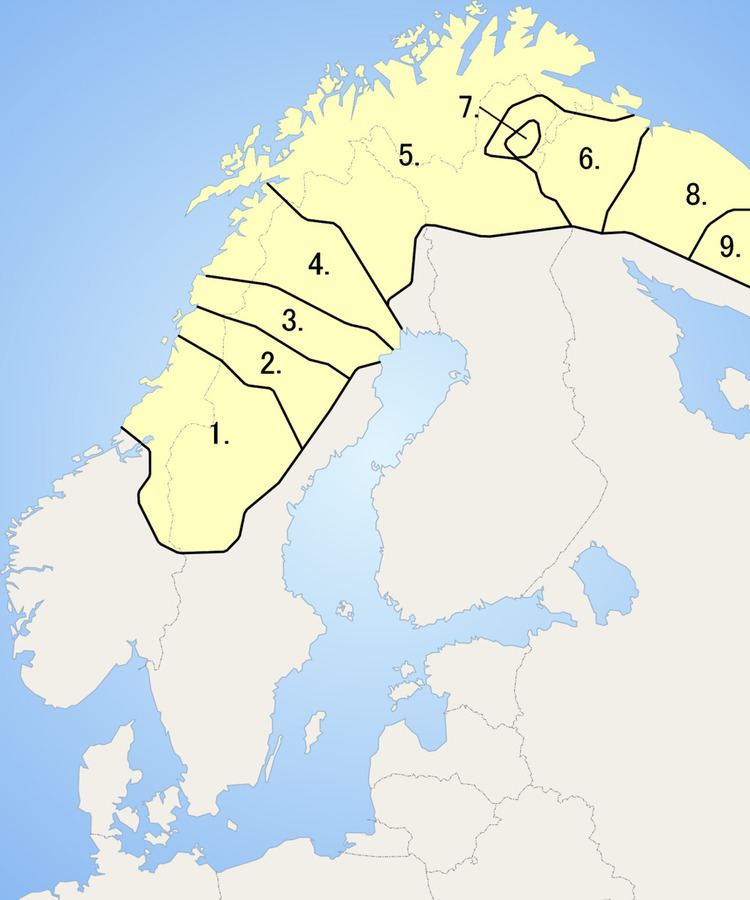Native to Finland Native speakers 300 (2001 census) Recognised minority
language in Finland | Ethnicity Inari Sami people Writing system Latin | |
 | ||
Language family Uralic
Sami
Eastern
Inari Sámi | ||
Inari Sámi (anarâškielâ) is a Sami language spoken by the Inari Sami of Finland. It has approximately 300 speakers, the majority of whom are middle-aged or older and live in the municipality of Inari. According to the Sami Parliament of Finland, 269 persons used Inari Sami as their first language. It is the only Sami language that is spoken exclusively in Finland. The language is classified as being seriously endangered as few children learn it.
Contents
History
The first book in Inari Sámi was Anar sämi kiela aapis kirje ja doctor Martti Lutherus Ucca katkismus, which was written and translated by Edvard Wilhelm Borg in 1859. The written history of modern Inari Sámi, however, is said to begin with Lauri Arvid Itkonen's translation of the history of the Bible in 1906, although he had already translated some other books into Inari Sámi (Martin Luther and John Charles Ryles). After that, Inari Sami was mainly published in books written by linguists, Frans Äimä and Erkki Itkonen, in particular. For many years, very little literature was written in Inari Sami, although Sämitigge has funded and published a lot of books, etc., in recent years.
Since 1992, Finland's Sami have had the right to interact with officials in their own language in areas where they have traditionally lived: Enontekiö, Utsjoki, Inari and the northern part of Sodankylä as official policy favors the conservation of the language. All announcements in Inari, which is the only officially quadrilingual municipality in Finland, must be made in Finnish, North Sami, Inari Sami and Skolt Sami. Only about 10% of the public servants in the area, however, can serve the Inari Saami-speaking population in Inari Saami, so Finnish is used by the remaining 90%.
In 1986, the Anarâškielâ servi (Inari Sámi Language Association) was founded to promote the language and its use. The association publishes numerous books, textbooks, a calendar, etc., in Inari Sami. They have established a language immersion program in 1997 for 3- to 6-year-old children in a day care in Inari and Ivalo. In 2007, the association started publishing an Inari Sámi newspaper called Kierâš online.
A new phenomenon see Inari Sami is being used in rap songs by Mikkal Morottaja, whose stage name is Amoc. Morottaja published the first full-length Inari Sámi rap CD in the world on February 6, 2007 (Sami National Day).
Geographic distribution
Along with Finnish, Skolt Sami and Northern Sami, Inari Sámi is one of the four official languages in the municipality of Inari, in particular in the following villages located on the shore of Lake Inari (the Inari Sámi name for the village is enclosed in parentheses):
Orthography
Inari Sámi is written using the Latin script. The alphabet currently used for Inari Sami was made official in 1996 and stands as follows:
The phonetic values are the same as in Karelian, and đ represents the voiced dental fricative (in English "the"). Q/q, W/w, X/x, Å/å, Ö/ö are also used in words of foreign origin. Á was traditionally pronounced in the middle of a and ä, but in modern Inari Sámi the distinction between á and ä is nonexistent. In writing, Á and ä are nevertheless considered separate characters. Ä is used in:
Cases
Inari Sámi has nine cases, although the genitive and accusative are often the same:
The partitive appears to be a highly unproductive case in that it seems to only be used in the singular. In addition, unlike Finnish, Inari Sámi does not make use of the partitive case for objects of transitive verbs. Thus "Mun puurâm leeibi" could translate into Finnish as either "Minä syön leivän" (English: I'm eating (all of) the bread) or "Minä syön leipää" (I'm eating (some) bread, or generally, I eat bread); this telicity contrast is mandatory in Finnish.
Pronouns
The personal pronouns have three numbers: singular, plural and dual. The following table contains personal pronouns in the nominative and genitive/accusative cases.
The next table demonstrates the declension of a personal pronoun I/we (dual)/we (plural) in the various cases:
Person
Inari Sami verbs conjugate for three grammatical persons:
Mood
Inari Sami has five grammatical moods:
Grammatical number
Inari Sami verbs conjugate for three grammatical numbers:
Tense
Inari Sami has two simple tenses:
and two compound tenses:
Negative verb
Inari Sami, like Finnish, the other Sámi languages and Estonian, has a negative verb. In Inari Sami, the negative verb conjugates according to mood (indicative, imperative and optative), person (1st, 2nd, 3rd) and number (singular, dual and plural).
Ind. pres. Imperative Optative sg. du pl. sg. du pl. sg. du pl. 1 jie'm iän ep 1 – – – 1 iällum iäl'loon iällup 2 jie'h eppee eppeđ 2 ele ellee elleđ 2 ele ellee elleđ 3 ij iä'vá iä 3 – – – 3 iä'lus iällus iällus